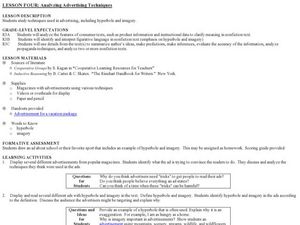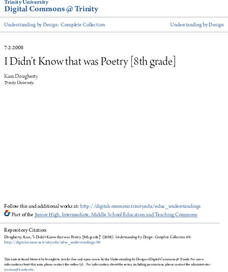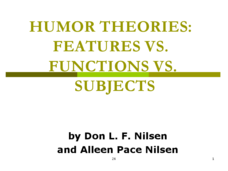E Reading Worksheets
Figurative Language Finder
To demonstrate their understanding of figurative language, middle schoolers use a guided reading instructional activity to find examples of figurative language in a text, identify the technique being used, and to explain how...
Newseum
Weed Out Propaganda
Young scholars study four essential propaganda techniques: Simplification, Exploitation, Exaggeration, and Division (S.E.E.D.). Individuals select an example of propaganda from the past and present then compare how the key elements have...
Curated OER
Analyzing Advertising Techniques
Students study hyperbole and imagery in advertising. In this advertising techniques lesson, students identify hyperbole and imagery in print advertisements.
Curated OER
I Know Why the Caged Bird Sings
Students examine the use of hyperbole in Maya Angelou's I Know Why the Caged Bird Sings. In this literary analysis lesson, students read and discuss chapter 31 from the story. Students write the definition for hyperbole and locate...
Curated OER
I Know Why the Caged Bird Sings: Chapters 34, 35
Students analyze Maya Angelou's I Know Why the Caged Bird Sings in part of an analysis of imagery. In this Maya Angelou lesson, students read chapters 34 and 35 in the novel and define imager. Students work in pairs to locate two...
Curated OER
Figurative Language 2
Students read nursery rhymes and advertisements to identify examples of figurative language. As a class, students discuss the use of figurative language and its effectiveness in advertising, children's books, rhymes, poetry, etc. ...
Trinity University
I Didn’t Know that was Poetry
Poetry or prose? That is the question facing middle schoolers as they begin a month-long poetry unit by examining the characteristics that differentiate poetry and prose writing. Pupils learn about poetic devices and different types of...
Eastconn
Learning to Analyze Political Cartoons with Lincoln as a Case Study
Discover the five main elements political cartoonists use—symbolism, captioning and labels, analogy, irony, and exaggeration—to convey their point of view.
Roald Dahl
The Twits - The Glass Eye and the Frog
What do a pair of stinky socks and a toy hamster have in common? The third lesson in an 11-part unit designed to accompany The Twits by Roald Dahl uses silly objects to teach about figurative language. Zany pranks and role play make...
Learning for Justice
Maya Angelou
Maya Angelou's poem, "Still I Rise", offers young scholars an opportunity to consider how poets use literary devices to create powerful messages. After a close reading and discussion of the poem, class members reflect on how they can...
Ereading Worksheets
Figurative Language for Edgar Allen Poe
Are your classes weary of dreary worksheets? Are the learners nearly napping? Thrill them, fill them with delight with an interactive worksheet that asks them to identify the figurative language Edgar Allen Poe uses to add horror and...
Prestwick House
Reading Nonfiction: Analyzing Joseph McCarthy's "Enemies from Within" Speech
Looking for a lesson that teaches class members how to analyze nonfiction? Use Joseph McCarthy's famous "Enemies from Within" speech as a instructional text. Worksheet questions direct readers' attention to the many historical...
K12 Reader
Working with Figurative Language
Are your middle schoolers able to identify the literary devices featured on this worksheet? They must demonstrate their understanding of figurative language by matching the terms with their definitions and label the devices...
Curated OER
The Notorious Hope Diamond: What Makes an American Legend?
Students view and discuss a video on the legend of the Hope Diamond then compare and contrast other tales such as Paul Bunyan, Pecos Bill and Johnny Appleseed. They analyze basic characteristics of these legends then use descriptive...
Curated OER
Satire: A Matter of Tone
Satire, anyone? After a review of terms associated with satire, viewers are directed to craft a 500-600 word piece of satire about a familiar hypocrisy.
Curated OER
Theater: Create a Script
Figurative language is the focus in the book Teach Us, Amelia Bedelia. After reading Peggy Parish's book, class members dramatize idioms from the text, using dramatic strategies such as characterization, exaggeration, and...
Curated OER
"Champion of the World"
“Champion of the World,” a chapter from Maya Angelou’s I Know Why the Caged Bird Sings, is the subject of a study guide that asks readers to consider the author’s purpose, the function of the chapter in the entire narrative, and...
Curated OER
Elements of Poetry
Prepare your learners to identify figurative language in poetry. Tips for reading poetry and what to look for are listed on these slides. Rhetorical devices are defined and plenty of examples are given.
Curated OER
How to Draw Caricatures
Caricature drawing is fun, and can help learners explore the principle of design and content specific vocabulary. They view a video and books that use character drawings, discuss vocabulary such as exaggeration, proportion, and symmetry,...
Curated OER
Humor Theories
Providing ample examples of humor in literature, psychology, and sociology, this presentation studies the concept and function of humor in society today. Covering what is classically "funny" and what is not, and why, the slideshow will...
Curated OER
Humor Theories: Features vs. Functions vs. Subjects
Great for a psychology, sociology, or language arts lecture, this presentation focuses on the features, functions, and subjects of humor. Complete with definitions and examples of each category, as well as links to humorous videos and...
Curated OER
How I Spent My Summer Vacation
Students hear the story How I Spent My Summer Vacation by Wallace Bleef and share their own summer experiences. They write a tale about one event that happened during their summer using exaggeration.
Curated OER
Figurative Language-Part 1
Students explore figurative language. In this figurative language lesson, students look up, define, and give examples of a list of literary terms.
Curated OER
Urban Legends
Irony, hyperbole, and other rhetorical devices are at play in this presentation about urban legends. Several examples of urban legends help to clarify the analysis, making it valuable for those who have a hard time wrapping their mind...
Other popular searches
- Hyperbole Examples Pictures
- Dr Seuss Hyperbole Examples
- Hyperbole Examples Sentences
- Hyperbole Examples of Book

























